BRE810 Research Report: HRM Issues in Australian Healthcare
VerifiedAdded on 2022/11/15
|10
|2810
|1
Report
AI Summary
This research report delves into the critical human resource management (HRM) issues impacting the Australian healthcare sector. The report begins by identifying the research problem, which centers around challenges such as high turnover rates, employee well-being, and the need for effective HR practices in a rapidly evolving healthcare landscape. The research questions explore the key issues faced by healthcare professionals, the challenges for HR professionals in implementing improvement strategies, and potential recommendations for addressing the situation. A comprehensive literature review examines the emerging trends in the Australian healthcare sector, including the impact of an aging population, changing disease patterns, and the increasing cost of medical equipment. The review also explores factors influencing HR practices, such as workforce efficiency, cost reduction policies, and the need for a diverse and skilled workforce. The report then outlines the required improvements in HR operations, emphasizing the role of training and development, staffing strategies, and performance management. The research paper aims to identify the core challenges faced by HR professionals and shed light on the key factors that drive employee engagement, ultimately offering insights into strategic drawbacks and providing recommendations for improvement. This report is a valuable resource for students studying leadership management, providing a detailed overview of HRM challenges and potential solutions within the Australian healthcare context.
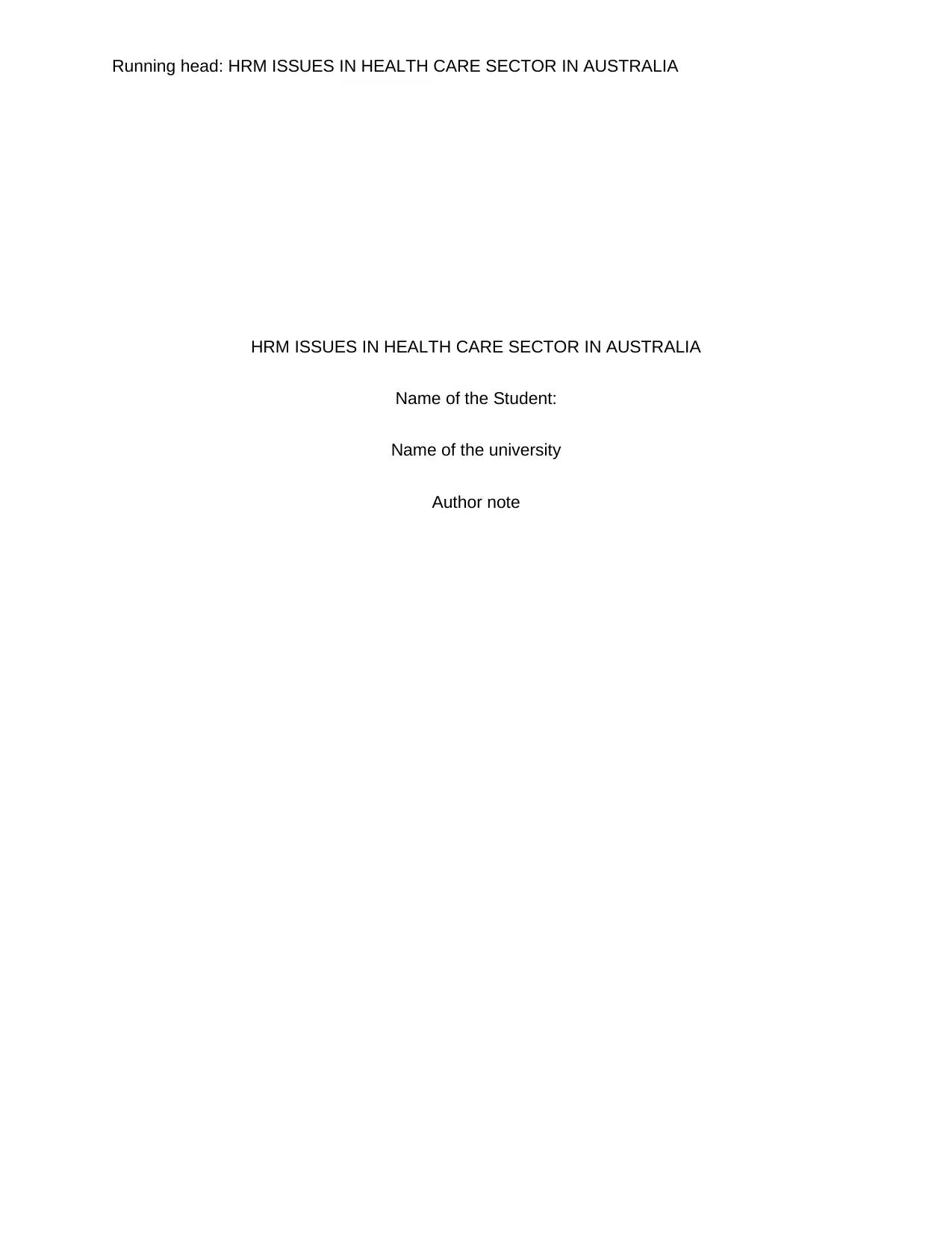
Running head: HRM ISSUES IN HEALTH CARE SECTOR IN AUSTRALIA
HRM ISSUES IN HEALTH CARE SECTOR IN AUSTRALIA
Name of the Student:
Name of the university
Author note
HRM ISSUES IN HEALTH CARE SECTOR IN AUSTRALIA
Name of the Student:
Name of the university
Author note
Paraphrase This Document
Need a fresh take? Get an instant paraphrase of this document with our AI Paraphraser
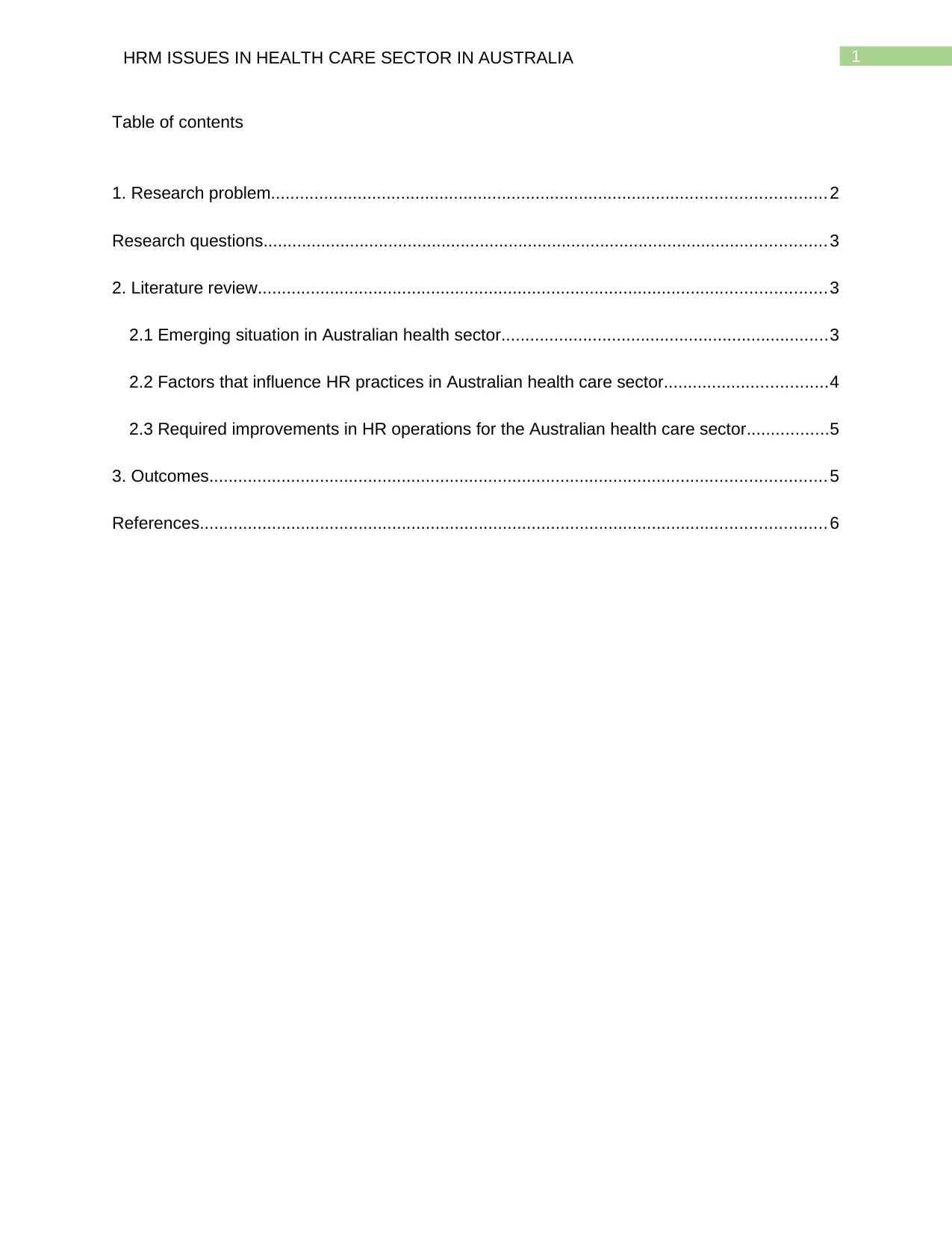
1HRM ISSUES IN HEALTH CARE SECTOR IN AUSTRALIA
Table of contents
1. Research problem................................................................................................................... 2
Research questions..................................................................................................................... 3
2. Literature review...................................................................................................................... 3
2.1 Emerging situation in Australian health sector....................................................................3
2.2 Factors that influence HR practices in Australian health care sector..................................4
2.3 Required improvements in HR operations for the Australian health care sector.................5
3. Outcomes................................................................................................................................ 5
References.................................................................................................................................. 6
Table of contents
1. Research problem................................................................................................................... 2
Research questions..................................................................................................................... 3
2. Literature review...................................................................................................................... 3
2.1 Emerging situation in Australian health sector....................................................................3
2.2 Factors that influence HR practices in Australian health care sector..................................4
2.3 Required improvements in HR operations for the Australian health care sector.................5
3. Outcomes................................................................................................................................ 5
References.................................................................................................................................. 6
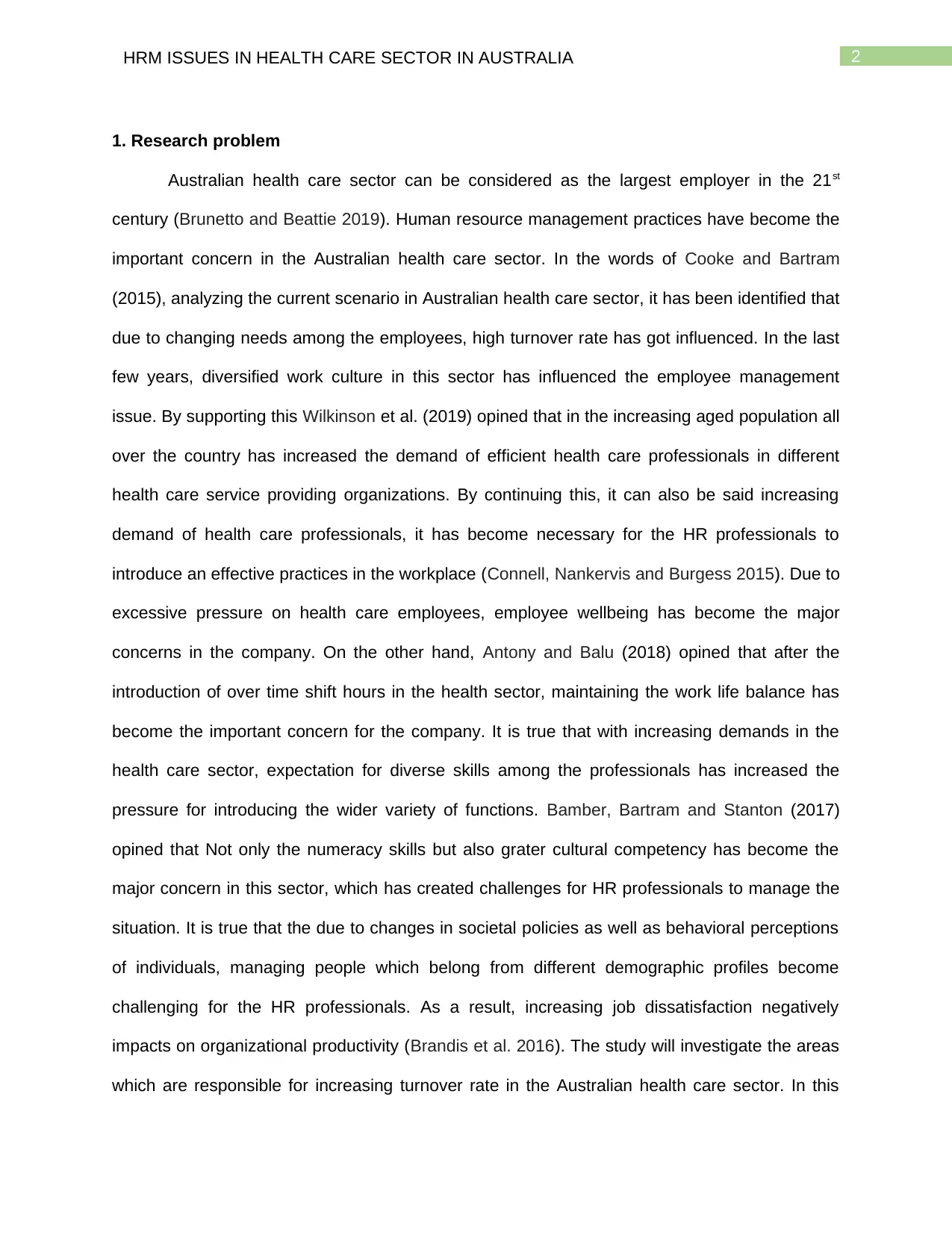
2HRM ISSUES IN HEALTH CARE SECTOR IN AUSTRALIA
1. Research problem
Australian health care sector can be considered as the largest employer in the 21st
century (Brunetto and Beattie 2019). Human resource management practices have become the
important concern in the Australian health care sector. In the words of Cooke and Bartram
(2015), analyzing the current scenario in Australian health care sector, it has been identified that
due to changing needs among the employees, high turnover rate has got influenced. In the last
few years, diversified work culture in this sector has influenced the employee management
issue. By supporting this Wilkinson et al. (2019) opined that in the increasing aged population all
over the country has increased the demand of efficient health care professionals in different
health care service providing organizations. By continuing this, it can also be said increasing
demand of health care professionals, it has become necessary for the HR professionals to
introduce an effective practices in the workplace (Connell, Nankervis and Burgess 2015). Due to
excessive pressure on health care employees, employee wellbeing has become the major
concerns in the company. On the other hand, Antony and Balu (2018) opined that after the
introduction of over time shift hours in the health sector, maintaining the work life balance has
become the important concern for the company. It is true that with increasing demands in the
health care sector, expectation for diverse skills among the professionals has increased the
pressure for introducing the wider variety of functions. Bamber, Bartram and Stanton (2017)
opined that Not only the numeracy skills but also grater cultural competency has become the
major concern in this sector, which has created challenges for HR professionals to manage the
situation. It is true that the due to changes in societal policies as well as behavioral perceptions
of individuals, managing people which belong from different demographic profiles become
challenging for the HR professionals. As a result, increasing job dissatisfaction negatively
impacts on organizational productivity (Brandis et al. 2016). The study will investigate the areas
which are responsible for increasing turnover rate in the Australian health care sector. In this
1. Research problem
Australian health care sector can be considered as the largest employer in the 21st
century (Brunetto and Beattie 2019). Human resource management practices have become the
important concern in the Australian health care sector. In the words of Cooke and Bartram
(2015), analyzing the current scenario in Australian health care sector, it has been identified that
due to changing needs among the employees, high turnover rate has got influenced. In the last
few years, diversified work culture in this sector has influenced the employee management
issue. By supporting this Wilkinson et al. (2019) opined that in the increasing aged population all
over the country has increased the demand of efficient health care professionals in different
health care service providing organizations. By continuing this, it can also be said increasing
demand of health care professionals, it has become necessary for the HR professionals to
introduce an effective practices in the workplace (Connell, Nankervis and Burgess 2015). Due to
excessive pressure on health care employees, employee wellbeing has become the major
concerns in the company. On the other hand, Antony and Balu (2018) opined that after the
introduction of over time shift hours in the health sector, maintaining the work life balance has
become the important concern for the company. It is true that with increasing demands in the
health care sector, expectation for diverse skills among the professionals has increased the
pressure for introducing the wider variety of functions. Bamber, Bartram and Stanton (2017)
opined that Not only the numeracy skills but also grater cultural competency has become the
major concern in this sector, which has created challenges for HR professionals to manage the
situation. It is true that the due to changes in societal policies as well as behavioral perceptions
of individuals, managing people which belong from different demographic profiles become
challenging for the HR professionals. As a result, increasing job dissatisfaction negatively
impacts on organizational productivity (Brandis et al. 2016). The study will investigate the areas
which are responsible for increasing turnover rate in the Australian health care sector. In this
⊘ This is a preview!⊘
Do you want full access?
Subscribe today to unlock all pages.

Trusted by 1+ million students worldwide
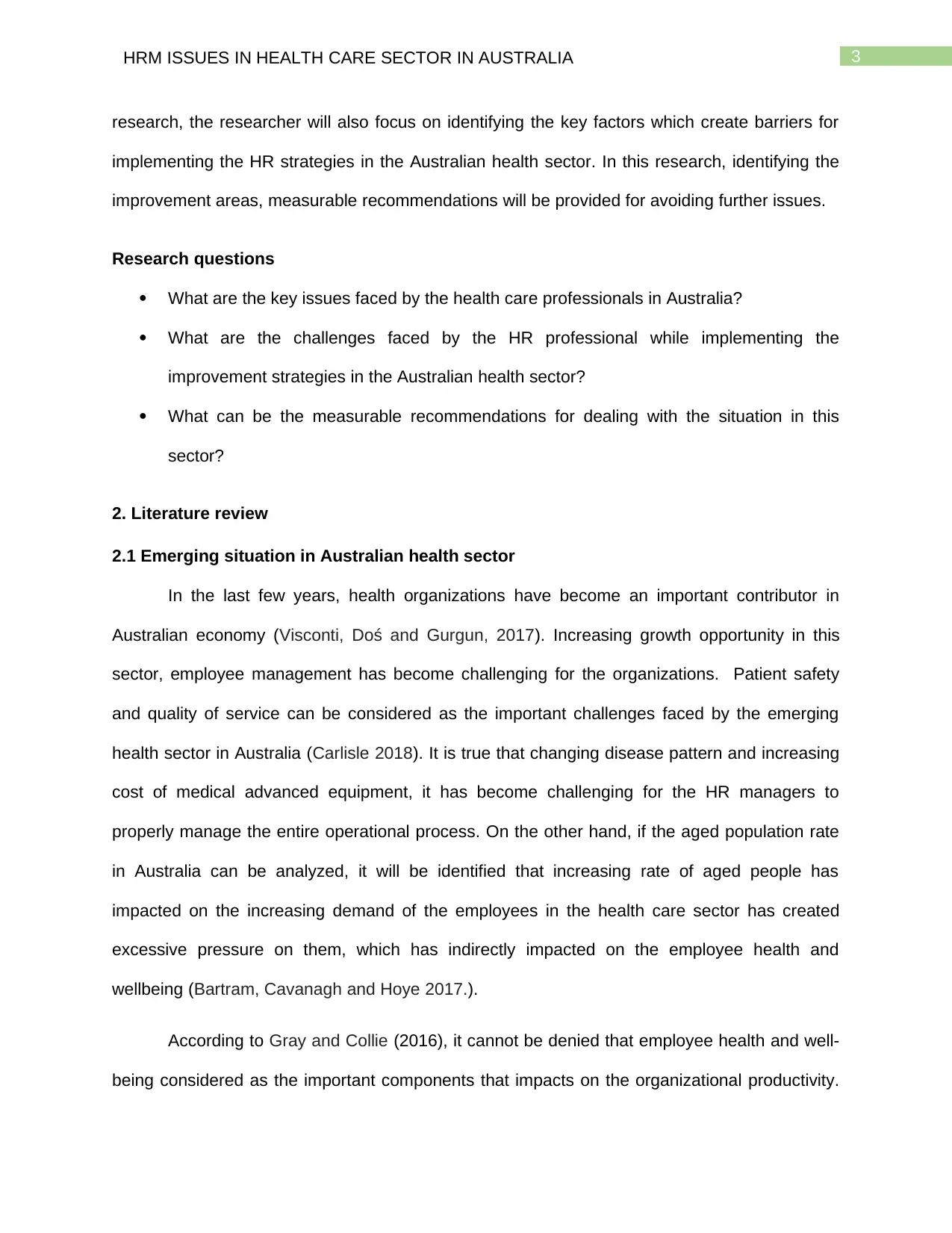
3HRM ISSUES IN HEALTH CARE SECTOR IN AUSTRALIA
research, the researcher will also focus on identifying the key factors which create barriers for
implementing the HR strategies in the Australian health sector. In this research, identifying the
improvement areas, measurable recommendations will be provided for avoiding further issues.
Research questions
What are the key issues faced by the health care professionals in Australia?
What are the challenges faced by the HR professional while implementing the
improvement strategies in the Australian health sector?
What can be the measurable recommendations for dealing with the situation in this
sector?
2. Literature review
2.1 Emerging situation in Australian health sector
In the last few years, health organizations have become an important contributor in
Australian economy (Visconti, Doś and Gurgun, 2017). Increasing growth opportunity in this
sector, employee management has become challenging for the organizations. Patient safety
and quality of service can be considered as the important challenges faced by the emerging
health sector in Australia (Carlisle 2018). It is true that changing disease pattern and increasing
cost of medical advanced equipment, it has become challenging for the HR managers to
properly manage the entire operational process. On the other hand, if the aged population rate
in Australia can be analyzed, it will be identified that increasing rate of aged people has
impacted on the increasing demand of the employees in the health care sector has created
excessive pressure on them, which has indirectly impacted on the employee health and
wellbeing (Bartram, Cavanagh and Hoye 2017.).
According to Gray and Collie (2016), it cannot be denied that employee health and well-
being considered as the important components that impacts on the organizational productivity.
research, the researcher will also focus on identifying the key factors which create barriers for
implementing the HR strategies in the Australian health sector. In this research, identifying the
improvement areas, measurable recommendations will be provided for avoiding further issues.
Research questions
What are the key issues faced by the health care professionals in Australia?
What are the challenges faced by the HR professional while implementing the
improvement strategies in the Australian health sector?
What can be the measurable recommendations for dealing with the situation in this
sector?
2. Literature review
2.1 Emerging situation in Australian health sector
In the last few years, health organizations have become an important contributor in
Australian economy (Visconti, Doś and Gurgun, 2017). Increasing growth opportunity in this
sector, employee management has become challenging for the organizations. Patient safety
and quality of service can be considered as the important challenges faced by the emerging
health sector in Australia (Carlisle 2018). It is true that changing disease pattern and increasing
cost of medical advanced equipment, it has become challenging for the HR managers to
properly manage the entire operational process. On the other hand, if the aged population rate
in Australia can be analyzed, it will be identified that increasing rate of aged people has
impacted on the increasing demand of the employees in the health care sector has created
excessive pressure on them, which has indirectly impacted on the employee health and
wellbeing (Bartram, Cavanagh and Hoye 2017.).
According to Gray and Collie (2016), it cannot be denied that employee health and well-
being considered as the important components that impacts on the organizational productivity.
Paraphrase This Document
Need a fresh take? Get an instant paraphrase of this document with our AI Paraphraser
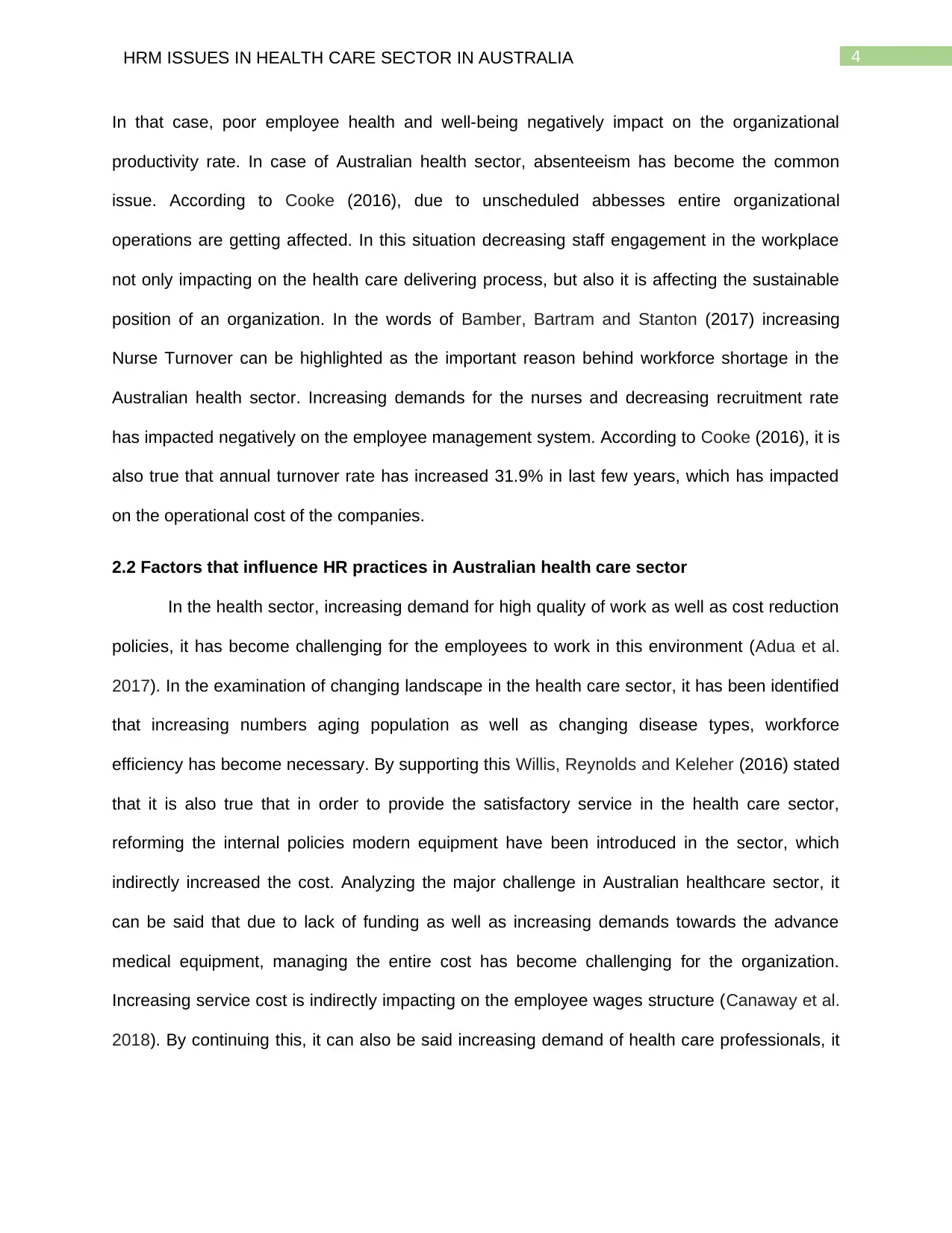
4HRM ISSUES IN HEALTH CARE SECTOR IN AUSTRALIA
In that case, poor employee health and well-being negatively impact on the organizational
productivity rate. In case of Australian health sector, absenteeism has become the common
issue. According to Cooke (2016), due to unscheduled abbesses entire organizational
operations are getting affected. In this situation decreasing staff engagement in the workplace
not only impacting on the health care delivering process, but also it is affecting the sustainable
position of an organization. In the words of Bamber, Bartram and Stanton (2017) increasing
Nurse Turnover can be highlighted as the important reason behind workforce shortage in the
Australian health sector. Increasing demands for the nurses and decreasing recruitment rate
has impacted negatively on the employee management system. According to Cooke (2016), it is
also true that annual turnover rate has increased 31.9% in last few years, which has impacted
on the operational cost of the companies.
2.2 Factors that influence HR practices in Australian health care sector
In the health sector, increasing demand for high quality of work as well as cost reduction
policies, it has become challenging for the employees to work in this environment (Adua et al.
2017). In the examination of changing landscape in the health care sector, it has been identified
that increasing numbers aging population as well as changing disease types, workforce
efficiency has become necessary. By supporting this Willis, Reynolds and Keleher (2016) stated
that it is also true that in order to provide the satisfactory service in the health care sector,
reforming the internal policies modern equipment have been introduced in the sector, which
indirectly increased the cost. Analyzing the major challenge in Australian healthcare sector, it
can be said that due to lack of funding as well as increasing demands towards the advance
medical equipment, managing the entire cost has become challenging for the organization.
Increasing service cost is indirectly impacting on the employee wages structure (Canaway et al.
2018). By continuing this, it can also be said increasing demand of health care professionals, it
In that case, poor employee health and well-being negatively impact on the organizational
productivity rate. In case of Australian health sector, absenteeism has become the common
issue. According to Cooke (2016), due to unscheduled abbesses entire organizational
operations are getting affected. In this situation decreasing staff engagement in the workplace
not only impacting on the health care delivering process, but also it is affecting the sustainable
position of an organization. In the words of Bamber, Bartram and Stanton (2017) increasing
Nurse Turnover can be highlighted as the important reason behind workforce shortage in the
Australian health sector. Increasing demands for the nurses and decreasing recruitment rate
has impacted negatively on the employee management system. According to Cooke (2016), it is
also true that annual turnover rate has increased 31.9% in last few years, which has impacted
on the operational cost of the companies.
2.2 Factors that influence HR practices in Australian health care sector
In the health sector, increasing demand for high quality of work as well as cost reduction
policies, it has become challenging for the employees to work in this environment (Adua et al.
2017). In the examination of changing landscape in the health care sector, it has been identified
that increasing numbers aging population as well as changing disease types, workforce
efficiency has become necessary. By supporting this Willis, Reynolds and Keleher (2016) stated
that it is also true that in order to provide the satisfactory service in the health care sector,
reforming the internal policies modern equipment have been introduced in the sector, which
indirectly increased the cost. Analyzing the major challenge in Australian healthcare sector, it
can be said that due to lack of funding as well as increasing demands towards the advance
medical equipment, managing the entire cost has become challenging for the organization.
Increasing service cost is indirectly impacting on the employee wages structure (Canaway et al.
2018). By continuing this, it can also be said increasing demand of health care professionals, it
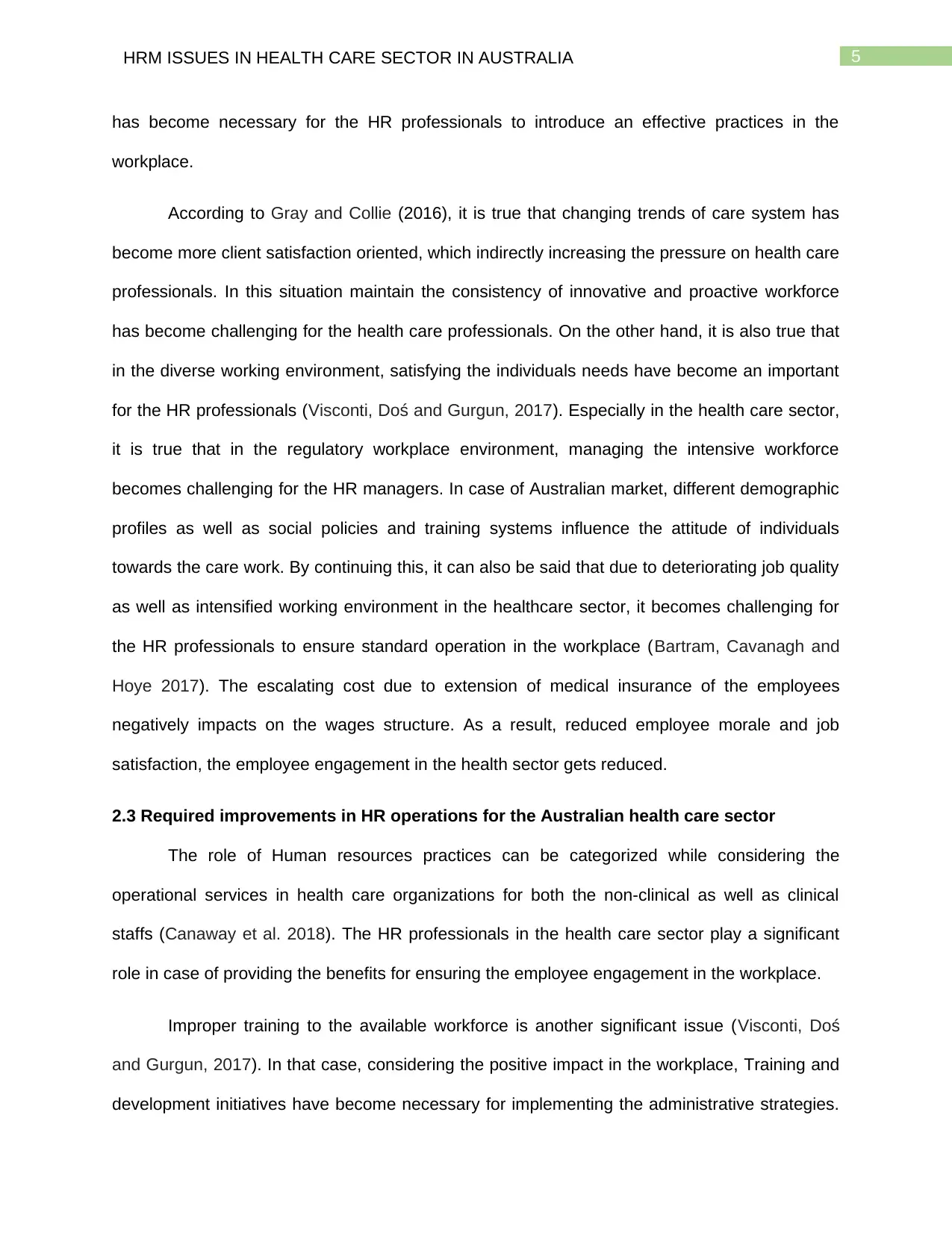
5HRM ISSUES IN HEALTH CARE SECTOR IN AUSTRALIA
has become necessary for the HR professionals to introduce an effective practices in the
workplace.
According to Gray and Collie (2016), it is true that changing trends of care system has
become more client satisfaction oriented, which indirectly increasing the pressure on health care
professionals. In this situation maintain the consistency of innovative and proactive workforce
has become challenging for the health care professionals. On the other hand, it is also true that
in the diverse working environment, satisfying the individuals needs have become an important
for the HR professionals (Visconti, Doś and Gurgun, 2017). Especially in the health care sector,
it is true that in the regulatory workplace environment, managing the intensive workforce
becomes challenging for the HR managers. In case of Australian market, different demographic
profiles as well as social policies and training systems influence the attitude of individuals
towards the care work. By continuing this, it can also be said that due to deteriorating job quality
as well as intensified working environment in the healthcare sector, it becomes challenging for
the HR professionals to ensure standard operation in the workplace (Bartram, Cavanagh and
Hoye 2017). The escalating cost due to extension of medical insurance of the employees
negatively impacts on the wages structure. As a result, reduced employee morale and job
satisfaction, the employee engagement in the health sector gets reduced.
2.3 Required improvements in HR operations for the Australian health care sector
The role of Human resources practices can be categorized while considering the
operational services in health care organizations for both the non-clinical as well as clinical
staffs (Canaway et al. 2018). The HR professionals in the health care sector play a significant
role in case of providing the benefits for ensuring the employee engagement in the workplace.
Improper training to the available workforce is another significant issue (Visconti, Doś
and Gurgun, 2017). In that case, considering the positive impact in the workplace, Training and
development initiatives have become necessary for implementing the administrative strategies.
has become necessary for the HR professionals to introduce an effective practices in the
workplace.
According to Gray and Collie (2016), it is true that changing trends of care system has
become more client satisfaction oriented, which indirectly increasing the pressure on health care
professionals. In this situation maintain the consistency of innovative and proactive workforce
has become challenging for the health care professionals. On the other hand, it is also true that
in the diverse working environment, satisfying the individuals needs have become an important
for the HR professionals (Visconti, Doś and Gurgun, 2017). Especially in the health care sector,
it is true that in the regulatory workplace environment, managing the intensive workforce
becomes challenging for the HR managers. In case of Australian market, different demographic
profiles as well as social policies and training systems influence the attitude of individuals
towards the care work. By continuing this, it can also be said that due to deteriorating job quality
as well as intensified working environment in the healthcare sector, it becomes challenging for
the HR professionals to ensure standard operation in the workplace (Bartram, Cavanagh and
Hoye 2017). The escalating cost due to extension of medical insurance of the employees
negatively impacts on the wages structure. As a result, reduced employee morale and job
satisfaction, the employee engagement in the health sector gets reduced.
2.3 Required improvements in HR operations for the Australian health care sector
The role of Human resources practices can be categorized while considering the
operational services in health care organizations for both the non-clinical as well as clinical
staffs (Canaway et al. 2018). The HR professionals in the health care sector play a significant
role in case of providing the benefits for ensuring the employee engagement in the workplace.
Improper training to the available workforce is another significant issue (Visconti, Doś
and Gurgun, 2017). In that case, considering the positive impact in the workplace, Training and
development initiatives have become necessary for implementing the administrative strategies.
⊘ This is a preview!⊘
Do you want full access?
Subscribe today to unlock all pages.

Trusted by 1+ million students worldwide
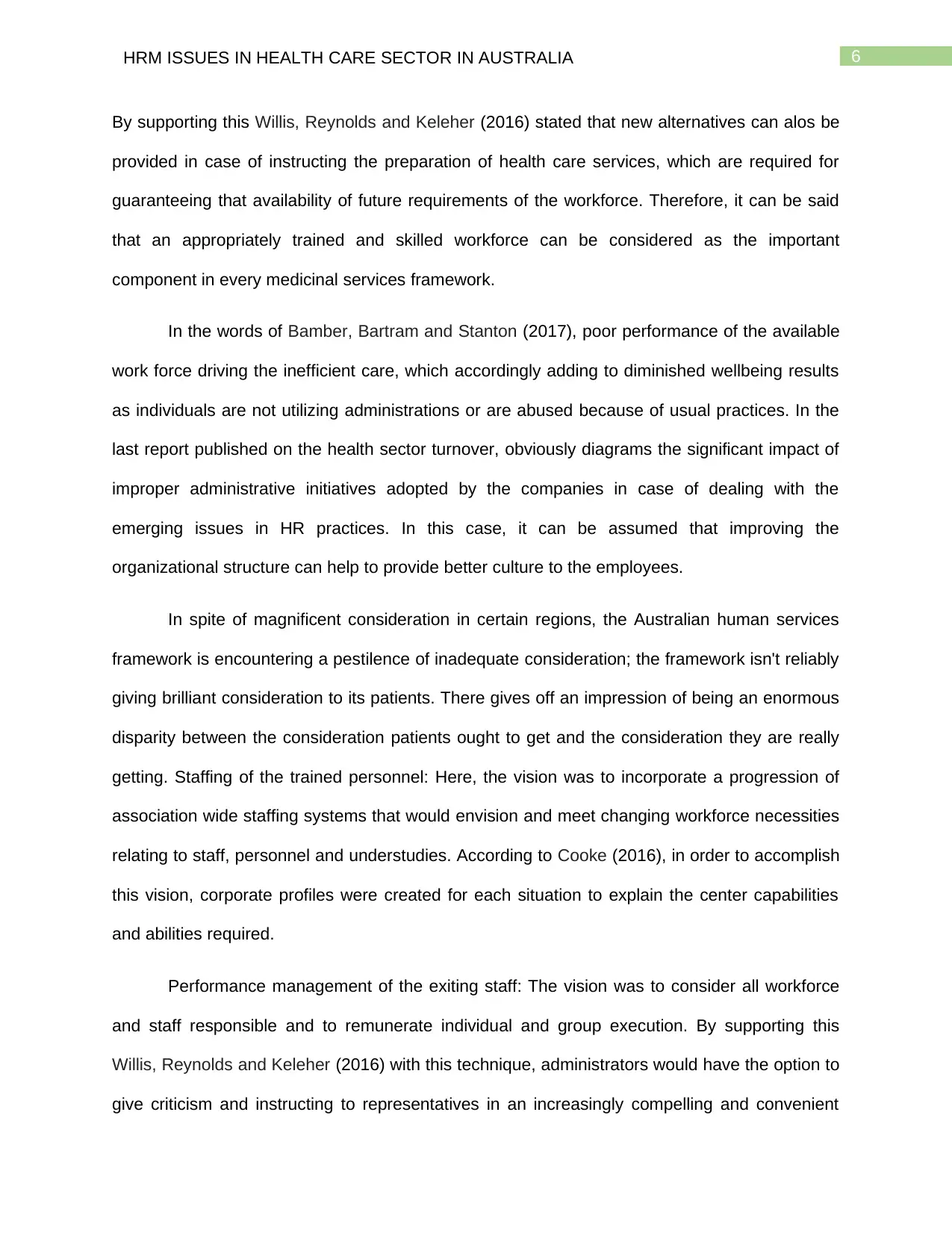
6HRM ISSUES IN HEALTH CARE SECTOR IN AUSTRALIA
By supporting this Willis, Reynolds and Keleher (2016) stated that new alternatives can alos be
provided in case of instructing the preparation of health care services, which are required for
guaranteeing that availability of future requirements of the workforce. Therefore, it can be said
that an appropriately trained and skilled workforce can be considered as the important
component in every medicinal services framework.
In the words of Bamber, Bartram and Stanton (2017), poor performance of the available
work force driving the inefficient care, which accordingly adding to diminished wellbeing results
as individuals are not utilizing administrations or are abused because of usual practices. In the
last report published on the health sector turnover, obviously diagrams the significant impact of
improper administrative initiatives adopted by the companies in case of dealing with the
emerging issues in HR practices. In this case, it can be assumed that improving the
organizational structure can help to provide better culture to the employees.
In spite of magnificent consideration in certain regions, the Australian human services
framework is encountering a pestilence of inadequate consideration; the framework isn't reliably
giving brilliant consideration to its patients. There gives off an impression of being an enormous
disparity between the consideration patients ought to get and the consideration they are really
getting. Staffing of the trained personnel: Here, the vision was to incorporate a progression of
association wide staffing systems that would envision and meet changing workforce necessities
relating to staff, personnel and understudies. According to Cooke (2016), in order to accomplish
this vision, corporate profiles were created for each situation to explain the center capabilities
and abilities required.
Performance management of the exiting staff: The vision was to consider all workforce
and staff responsible and to remunerate individual and group execution. By supporting this
Willis, Reynolds and Keleher (2016) with this technique, administrators would have the option to
give criticism and instructing to representatives in an increasingly compelling and convenient
By supporting this Willis, Reynolds and Keleher (2016) stated that new alternatives can alos be
provided in case of instructing the preparation of health care services, which are required for
guaranteeing that availability of future requirements of the workforce. Therefore, it can be said
that an appropriately trained and skilled workforce can be considered as the important
component in every medicinal services framework.
In the words of Bamber, Bartram and Stanton (2017), poor performance of the available
work force driving the inefficient care, which accordingly adding to diminished wellbeing results
as individuals are not utilizing administrations or are abused because of usual practices. In the
last report published on the health sector turnover, obviously diagrams the significant impact of
improper administrative initiatives adopted by the companies in case of dealing with the
emerging issues in HR practices. In this case, it can be assumed that improving the
organizational structure can help to provide better culture to the employees.
In spite of magnificent consideration in certain regions, the Australian human services
framework is encountering a pestilence of inadequate consideration; the framework isn't reliably
giving brilliant consideration to its patients. There gives off an impression of being an enormous
disparity between the consideration patients ought to get and the consideration they are really
getting. Staffing of the trained personnel: Here, the vision was to incorporate a progression of
association wide staffing systems that would envision and meet changing workforce necessities
relating to staff, personnel and understudies. According to Cooke (2016), in order to accomplish
this vision, corporate profiles were created for each situation to explain the center capabilities
and abilities required.
Performance management of the exiting staff: The vision was to consider all workforce
and staff responsible and to remunerate individual and group execution. By supporting this
Willis, Reynolds and Keleher (2016) with this technique, administrators would have the option to
give criticism and instructing to representatives in an increasingly compelling and convenient
Paraphrase This Document
Need a fresh take? Get an instant paraphrase of this document with our AI Paraphraser
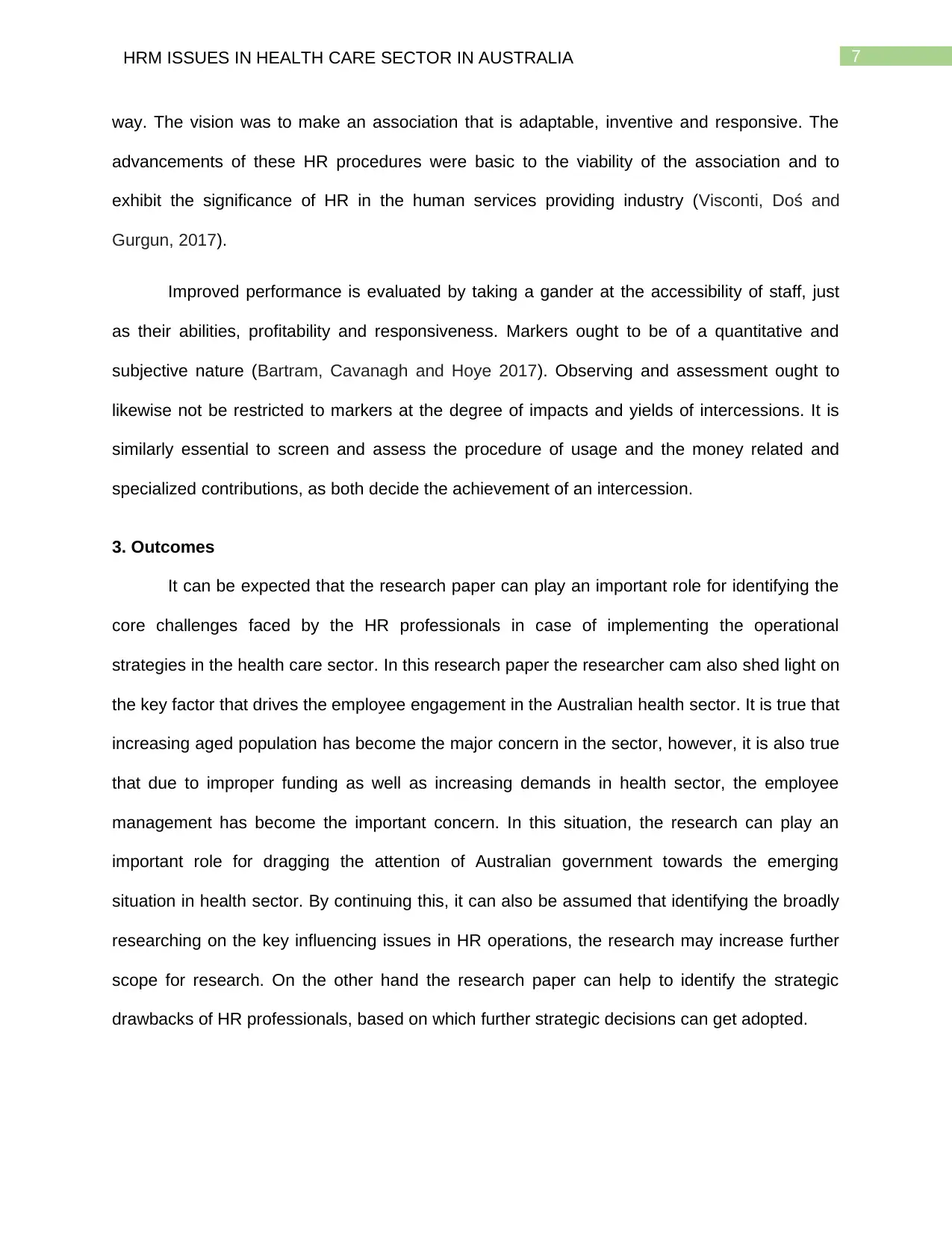
7HRM ISSUES IN HEALTH CARE SECTOR IN AUSTRALIA
way. The vision was to make an association that is adaptable, inventive and responsive. The
advancements of these HR procedures were basic to the viability of the association and to
exhibit the significance of HR in the human services providing industry (Visconti, Doś and
Gurgun, 2017).
Improved performance is evaluated by taking a gander at the accessibility of staff, just
as their abilities, profitability and responsiveness. Markers ought to be of a quantitative and
subjective nature (Bartram, Cavanagh and Hoye 2017). Observing and assessment ought to
likewise not be restricted to markers at the degree of impacts and yields of intercessions. It is
similarly essential to screen and assess the procedure of usage and the money related and
specialized contributions, as both decide the achievement of an intercession.
3. Outcomes
It can be expected that the research paper can play an important role for identifying the
core challenges faced by the HR professionals in case of implementing the operational
strategies in the health care sector. In this research paper the researcher cam also shed light on
the key factor that drives the employee engagement in the Australian health sector. It is true that
increasing aged population has become the major concern in the sector, however, it is also true
that due to improper funding as well as increasing demands in health sector, the employee
management has become the important concern. In this situation, the research can play an
important role for dragging the attention of Australian government towards the emerging
situation in health sector. By continuing this, it can also be assumed that identifying the broadly
researching on the key influencing issues in HR operations, the research may increase further
scope for research. On the other hand the research paper can help to identify the strategic
drawbacks of HR professionals, based on which further strategic decisions can get adopted.
way. The vision was to make an association that is adaptable, inventive and responsive. The
advancements of these HR procedures were basic to the viability of the association and to
exhibit the significance of HR in the human services providing industry (Visconti, Doś and
Gurgun, 2017).
Improved performance is evaluated by taking a gander at the accessibility of staff, just
as their abilities, profitability and responsiveness. Markers ought to be of a quantitative and
subjective nature (Bartram, Cavanagh and Hoye 2017). Observing and assessment ought to
likewise not be restricted to markers at the degree of impacts and yields of intercessions. It is
similarly essential to screen and assess the procedure of usage and the money related and
specialized contributions, as both decide the achievement of an intercession.
3. Outcomes
It can be expected that the research paper can play an important role for identifying the
core challenges faced by the HR professionals in case of implementing the operational
strategies in the health care sector. In this research paper the researcher cam also shed light on
the key factor that drives the employee engagement in the Australian health sector. It is true that
increasing aged population has become the major concern in the sector, however, it is also true
that due to improper funding as well as increasing demands in health sector, the employee
management has become the important concern. In this situation, the research can play an
important role for dragging the attention of Australian government towards the emerging
situation in health sector. By continuing this, it can also be assumed that identifying the broadly
researching on the key influencing issues in HR operations, the research may increase further
scope for research. On the other hand the research paper can help to identify the strategic
drawbacks of HR professionals, based on which further strategic decisions can get adopted.
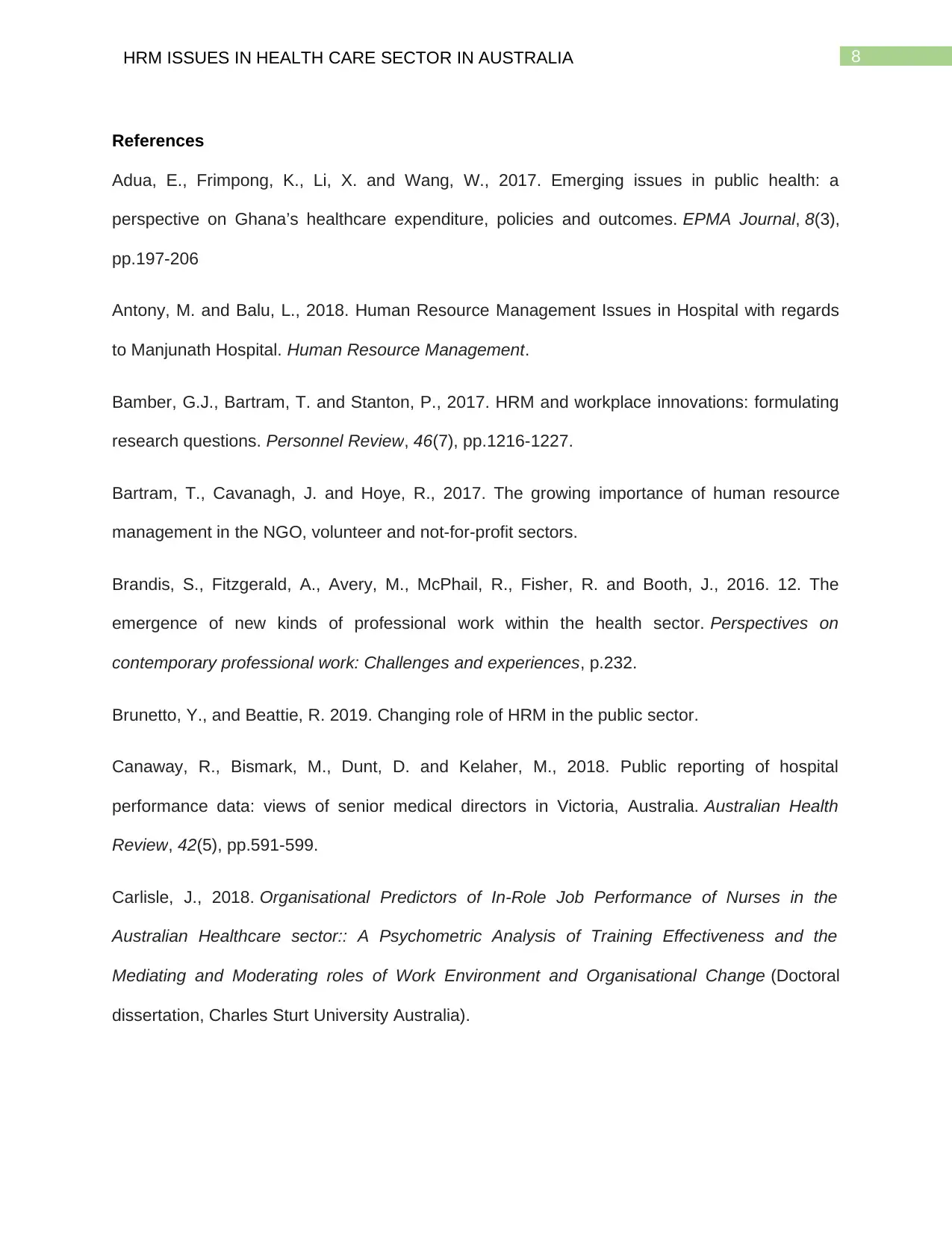
8HRM ISSUES IN HEALTH CARE SECTOR IN AUSTRALIA
References
Adua, E., Frimpong, K., Li, X. and Wang, W., 2017. Emerging issues in public health: a
perspective on Ghana’s healthcare expenditure, policies and outcomes. EPMA Journal, 8(3),
pp.197-206
Antony, M. and Balu, L., 2018. Human Resource Management Issues in Hospital with regards
to Manjunath Hospital. Human Resource Management.
Bamber, G.J., Bartram, T. and Stanton, P., 2017. HRM and workplace innovations: formulating
research questions. Personnel Review, 46(7), pp.1216-1227.
Bartram, T., Cavanagh, J. and Hoye, R., 2017. The growing importance of human resource
management in the NGO, volunteer and not-for-profit sectors.
Brandis, S., Fitzgerald, A., Avery, M., McPhail, R., Fisher, R. and Booth, J., 2016. 12. The
emergence of new kinds of professional work within the health sector. Perspectives on
contemporary professional work: Challenges and experiences, p.232.
Brunetto, Y., and Beattie, R. 2019. Changing role of HRM in the public sector.
Canaway, R., Bismark, M., Dunt, D. and Kelaher, M., 2018. Public reporting of hospital
performance data: views of senior medical directors in Victoria, Australia. Australian Health
Review, 42(5), pp.591-599.
Carlisle, J., 2018. Organisational Predictors of In-Role Job Performance of Nurses in the
Australian Healthcare sector:: A Psychometric Analysis of Training Effectiveness and the
Mediating and Moderating roles of Work Environment and Organisational Change (Doctoral
dissertation, Charles Sturt University Australia).
References
Adua, E., Frimpong, K., Li, X. and Wang, W., 2017. Emerging issues in public health: a
perspective on Ghana’s healthcare expenditure, policies and outcomes. EPMA Journal, 8(3),
pp.197-206
Antony, M. and Balu, L., 2018. Human Resource Management Issues in Hospital with regards
to Manjunath Hospital. Human Resource Management.
Bamber, G.J., Bartram, T. and Stanton, P., 2017. HRM and workplace innovations: formulating
research questions. Personnel Review, 46(7), pp.1216-1227.
Bartram, T., Cavanagh, J. and Hoye, R., 2017. The growing importance of human resource
management in the NGO, volunteer and not-for-profit sectors.
Brandis, S., Fitzgerald, A., Avery, M., McPhail, R., Fisher, R. and Booth, J., 2016. 12. The
emergence of new kinds of professional work within the health sector. Perspectives on
contemporary professional work: Challenges and experiences, p.232.
Brunetto, Y., and Beattie, R. 2019. Changing role of HRM in the public sector.
Canaway, R., Bismark, M., Dunt, D. and Kelaher, M., 2018. Public reporting of hospital
performance data: views of senior medical directors in Victoria, Australia. Australian Health
Review, 42(5), pp.591-599.
Carlisle, J., 2018. Organisational Predictors of In-Role Job Performance of Nurses in the
Australian Healthcare sector:: A Psychometric Analysis of Training Effectiveness and the
Mediating and Moderating roles of Work Environment and Organisational Change (Doctoral
dissertation, Charles Sturt University Australia).
⊘ This is a preview!⊘
Do you want full access?
Subscribe today to unlock all pages.

Trusted by 1+ million students worldwide
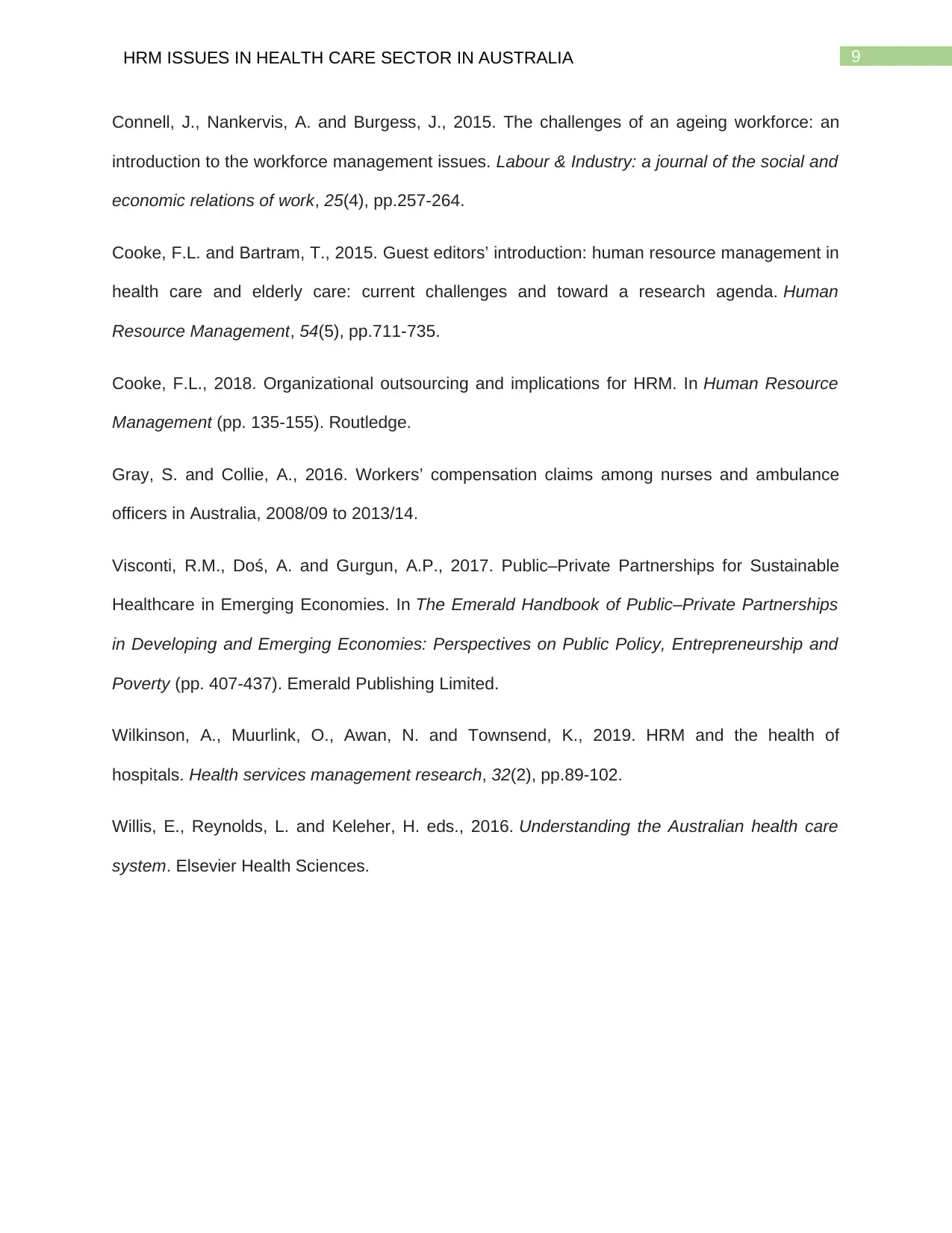
9HRM ISSUES IN HEALTH CARE SECTOR IN AUSTRALIA
Connell, J., Nankervis, A. and Burgess, J., 2015. The challenges of an ageing workforce: an
introduction to the workforce management issues. Labour & Industry: a journal of the social and
economic relations of work, 25(4), pp.257-264.
Cooke, F.L. and Bartram, T., 2015. Guest editors’ introduction: human resource management in
health care and elderly care: current challenges and toward a research agenda. Human
Resource Management, 54(5), pp.711-735.
Cooke, F.L., 2018. Organizational outsourcing and implications for HRM. In Human Resource
Management (pp. 135-155). Routledge.
Gray, S. and Collie, A., 2016. Workers’ compensation claims among nurses and ambulance
officers in Australia, 2008/09 to 2013/14.
Visconti, R.M., Doś, A. and Gurgun, A.P., 2017. Public–Private Partnerships for Sustainable
Healthcare in Emerging Economies. In The Emerald Handbook of Public–Private Partnerships
in Developing and Emerging Economies: Perspectives on Public Policy, Entrepreneurship and
Poverty (pp. 407-437). Emerald Publishing Limited.
Wilkinson, A., Muurlink, O., Awan, N. and Townsend, K., 2019. HRM and the health of
hospitals. Health services management research, 32(2), pp.89-102.
Willis, E., Reynolds, L. and Keleher, H. eds., 2016. Understanding the Australian health care
system. Elsevier Health Sciences.
Connell, J., Nankervis, A. and Burgess, J., 2015. The challenges of an ageing workforce: an
introduction to the workforce management issues. Labour & Industry: a journal of the social and
economic relations of work, 25(4), pp.257-264.
Cooke, F.L. and Bartram, T., 2015. Guest editors’ introduction: human resource management in
health care and elderly care: current challenges and toward a research agenda. Human
Resource Management, 54(5), pp.711-735.
Cooke, F.L., 2018. Organizational outsourcing and implications for HRM. In Human Resource
Management (pp. 135-155). Routledge.
Gray, S. and Collie, A., 2016. Workers’ compensation claims among nurses and ambulance
officers in Australia, 2008/09 to 2013/14.
Visconti, R.M., Doś, A. and Gurgun, A.P., 2017. Public–Private Partnerships for Sustainable
Healthcare in Emerging Economies. In The Emerald Handbook of Public–Private Partnerships
in Developing and Emerging Economies: Perspectives on Public Policy, Entrepreneurship and
Poverty (pp. 407-437). Emerald Publishing Limited.
Wilkinson, A., Muurlink, O., Awan, N. and Townsend, K., 2019. HRM and the health of
hospitals. Health services management research, 32(2), pp.89-102.
Willis, E., Reynolds, L. and Keleher, H. eds., 2016. Understanding the Australian health care
system. Elsevier Health Sciences.
1 out of 10
Related Documents
Your All-in-One AI-Powered Toolkit for Academic Success.
+13062052269
info@desklib.com
Available 24*7 on WhatsApp / Email
![[object Object]](/_next/static/media/star-bottom.7253800d.svg)
Unlock your academic potential
Copyright © 2020–2025 A2Z Services. All Rights Reserved. Developed and managed by ZUCOL.




